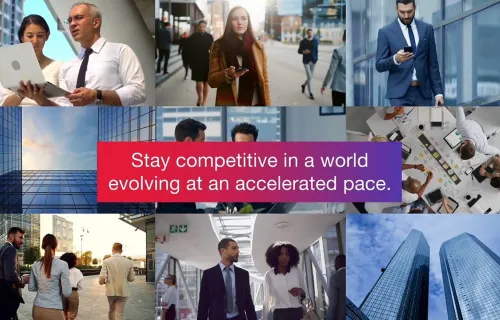We have an approach called ‘Fit for the Future’ when working with clients on strategy. We use this to shape our thinking and approach when helping clients plan how they adapt to upcoming changes in the insurance landscape. However, anyone reading the insurance news right now may feel a little confused as to what the future actually looks like. There seems to be an awful lot of noise about change going on, lots of potential but also a lot of stumbles along the way.
Lloyd’s Blueprint 2 digitisation initiative to create a more data driven market has moved forward with new data standards, only to see the second phase of that project paused to allow the market to adjust to the first phase of change. There is also uncertainty around the digital exchanges for the London market. Along with the re-launch of the Lloyd’s backed PPL platform, we now have multiple exchanges gaining interest, Whitespace & EBIX being two examples. This creates a more complex and potentially fragmented digital trading environment, but also a more vibrant one.
In General Insurance, the big news is the unexpected (though some would say unsurprising) exit of Amazon after only 2 years, without really making waves. All the while the InsurTech space continues to churn with ideas, but still seems to be very much on the edge of the industry. This in the face of ongoing questions about the viability of the new InsurTech business models, like Lemonade, who are yet to convince the market they have a profitable model or the surprisingly poor feedback on the claims experience of the Tesla insurance service.
Under Pressure
It feels like things should be moving faster but the reality is most insurers are facing more fundamental pressures in the near term. We roll these up to five core areas: cost, customer, competitiveness, capability and compliance. All demand insurers attention, while they also juggle managing a shifting business and technology landscape.
- Cost: Margin pressures are still hampering organisations’ cost base, particularly with the impact of claims inflation on bottom line. This isn’t made any easier with insurance organisations still dealing with the cost of changing and running legacy processes and systems. Improving operation efficiency continues to be difficult and costly.
- Customer: Both personal and business lines customer expectations have been raised by other industries showing the way in servicing customer needs. While improvements have been made in insurance, we are still relying on digital veneers overlaying legacy processes hampered by lack of access to consistent data.
- Competitiveness: Competitive advantage is being sought through data to create personalised experiences and products. Most organisations I speak to are still struggling with getting the data basics right. Silos, islands and swamps still make it difficult to deliver even a basic single view of a customer. This is before we consider the opportunity and challenge of external data from third parties or IOT (Internet of Things) solutions. The complexity and volume of valuable data to be consumed is only going to increase.
- Capability: Our recent Voice of Our Client survey underlined that improving business capability by attracting new talent is an ongoing worry for insurers. The debate on return to the office versus hybrid working increases the challenge. Providing the right balance needs a modern working environment and tools. Clunky systems and processes historically based on moving paper around present a barrier to attracting and retaining new talent.
- Compliance: Finally, compliance is not going away. Resilience is a concern for the regulator, especially the increasing reliance on third party services. There is opportunity to use compliance and intelligent processing to improve processes while making it an invisible part of the process and reducing the impact on staff.
Value at the intersection
While these business change drivers are a focus, insurers planning their strategy can’t ignore the impact on the pace of change of three broad technologies - Data, Artificial Intelligence (and not just GenAI!) and Platform.
- Data: While data has always been key to the insurance market, the sheer quantity and velocity of data available is far greater than ever before. New sources of real time data through connected assets and smart things (buildings, machines, vehicles, people) can feed insurers pricing and risk analysis. But only if they can consume and process the data and turn it into actionable insights. Traditionally unstructured data also becomes a more accessible source of insights with new capabilities Large Language Models (LLMs) offer.
- Intelligence: Automation and AI in particular has been used for a long time now – we have practical use cases in CGI going back 20 years. Generative AI (GenAI) has caught the attention and raised expectations of AI as a tool with disruptive potential. The seemingly exponential increase in capability makes it a key consideration for any strategy. However, AI needs to be coupled with deep thinking on how it could be used, along with good quality data to deliver on its promise. The ability to understand unstructured or visual data, offers a step change in how insurers could adapt their operating models and services.
- Platform: The final disruptive technology force is access to cloud platforms and solutions. For business leaders the key consideration is how it lowers the barrier to entry for smaller entrants or specialists. Removing the traditional high capital expenditure spending barrier to access technology reduces the protection large established organisations had in the past. New entrants can compete on a more level technology playing field. Established organisations can innovate and learn fast without needing to dig quite so deeply into pockets already stretched supporting legacy systems.
It is only when organisations look across the intersection of these core technology trends that things start to get interesting. By applying the right thinking and looking to challenge traditional business models and processes, the value of the intersectional impact of technology on business really shines. The diagram below shows just a few examples of the shifts possible if we just think beyond automating what we already do today.
Unfortunately, anyone reviewing the recent news can be forgiven for thinking that GenAI will single handedly ride in on a white charger and completely change the insurance landscape. The apparent capability of OpenAI’s ChatGPT or the launch of Microsoft Copilot, are tempting suggestions of the potential game changing intelligent automation that insurance organisations can't ignore.
Our view is that AI on its own is not going to solve all the challenges faced by the insurance industry. It is a common failure of strategy to focus on a single technology solution rather than extending the thinking to consider the intersection of different technologies.
Uber succeeded not by innovating on a new technology but rather by bringing several existing technologies together in a smarter way to challenge an existing business model. Henry Ford transformed car manufacturing not through the application of a new technology but by reorganising the blocks of an inefficient process to radically alter what was possible from an efficiency standpoint.
To succeed in making insurance ‘Fit for the Future’ we need to reduce the immediate burden of the current operating models, while also thinking beyond just using technology to automate what we do today to be more efficient. We need to think deeply on how we could adapt current operating models and products to take advantage of the technology intersection.
In my next blog I’ll focus on the next step in our approach, discuss why digital transformation sucks, and why we need to keep it human if we are going to succeed in getting ‘Fit for the Future’. In the meantime, please feel free to get in touch if you’d like to discuss the topics covered in this blog.







